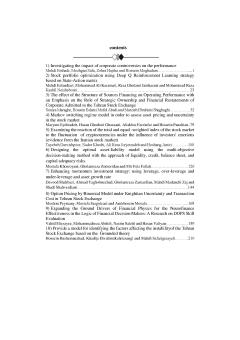Option Pricing by Binomial Model under Knightian Uncertainty and Transaction Cost in Tehran Stock Exchange
Subject Areas : Financial engineering
Moslem Peymani
1
,
Mostafa Sargolzaei
2
,
Amir Hosein Mosafa
3
![]()
1 - Department of Finance and Banking, Faculty of Management & Accounting, Allame Tabataba'i University, Tehran, Iran
2 - Department of Management and Accounting , University of Allameh Tabataba’i, Tehran. Iran
3 - Department of Finance and Banking Faculty of Management and Accounting Allameh Tabataba'I University. Tehran, Iran
Keywords: Tehran Stock Exchange, Transaction cost, Option, Binomial Model, Knightian Uncertainty,
Abstract :
Options are one of the most important derivatives that are trading in most major stock exchanges in today’s world. One of the basic issues in the field of these bonds is valuation and the Binomial model one of the common methods, but it has a number of problems such as the absence of transaction costs and Knightian uncertainty, which have been solved in this research. The purpose in this research is to compare the binomial model under Knightian uncertainty and transaction cost with the Black-Scholes-Merton model. By using these two models, in this research priced options were published since 1397 until the end of 1401. After estimating the theoretical prices of each of the models, it is compared with the market prices, and the amount of prediction error of each of them is calculated using the root mean square error (RMSE). The obtained results show that the Black-Scholes-Merton model has less error than the binomial tree model under Knightian uncertainty and transaction cost. By removing the transaction cost from research model, the error of this model is reduced, and in the symbol-day data that are in the money, this model has a lower error than the Black-Scholes-Merton model.
_|1) افشار، علی. (1401). مقایسه روشهای مختلف تخمین نوسان در ارزش¬گذاری اوراق اختیار معامله. پایاننامه کارشناسی ارشد. دانشگاه علامه طباطبائی.
2) امیری، مهدیه. (1399). قیمتگذاری قراردادهای اختیارمعامله با روشهای بلک- شولز،بونس و دوجملهای (مطالعه موردی: قراردادهای اختیار معامله سکه طلا در بورس کالای ایران)، فصلنامه بورس اوراق بهادار، 13(50)، 141-170.
3) جلوداری ممقانی، م. (1395). نظریهی آربیتراژ زمان پیوسته. تهران: انتشارات دانشگاه علامه طباطبائی.
4) خوزین، علی و دنکوب، مرتضی. (1390). اولویتبندی عوامل مؤثر در بهکارگیری اوراق مشتقه در بورس اوراق بهادار تهران، فصلنامه مهندسی مالی و مدیریت اوراق بهادار، 2(7)، 145-165.
5) زینل زاده، وحیده. (1394). قیمت¬گذاری اختیار معامله با درخت دوجملهای ضمنی. پایاننامه کارشناسی ارشد. دانشگاه علم و فرهنگ تهران.
6) سفیدفرد، فهیمه. (1397). قیمت¬گذاری اختیار معامله به روش درخت دوجملهای. پایاننامه کارشناسی ارشد. دانشگاه شهید باهنر کرمان.
7) کشتکاری، معصومه و علومی یزدی، حمیدرضا. (1392). ساختار و چالشهای حقوقی قرارداد اختیار معامله، مجله مطالعات فقه و حقوق اسلامی، 5(8)، 123.
8) کیمیاگری، علیمحمد؛ حاجیزاده، احسان؛ دستخوان، حسین و رمضانی، مجید. (1396). ارائه یک مدل ترکیبی جدید بهمنظور قیمتگذاری قراردادهای اختیار اروپایی. نشریه بینالمللی مهندسی صنایع و مدیریت تولید; ۲۸ (۱) :۹۹-۸۷.
9) لطفی آصف، هاجر. (1398). بررسی مدل بلک-شولز برای قیمتگذاری اختیار معامله با استفاده از نظریه فازی. پایاننامه کارشناسی ارشد. دانشگاه علم و فرهنگ تهران.
10) ماه آورپور، راضیه؛ مشایخ، شهناز و رحمانی، علی. (1400). شناسایی چالشهای پیادهسازی استانداردهای بینالمللی حسابداری ابزارهای مشتقه: با تأکید بر الزامات افشا، فصلنامه بورس اوراق بهادار، 14(55)، 160-186.
11) مرادی نیک، هادی. (1401). بررسی مدلهای قیمتگذاری اختیار معامله: مطالعه موردی معاملات اختیار بورس تهران. پایاننامه کارشناسی ارشد. دانشگاه تهران.
12) ملک محمدی، سارا. (1399). مقایسه عملکرد مدلهای ارزش¬گذاری اوراق اختیار معامله در بورس اوراق بهادار تهران. پایاننامه کارشناسی ارشد. دانشگاه علامه طباطبائی.
13) مهردوست، فرشید و صابر، نغمه. (1393). قیمتگذاری اختیار معامله تحت مدل هستون مضاعف با پرش. مجله مدلسازی پیشرفته ریاضی, 3(2), 45-60.
14) نیسی، ع. و پیمانی فروشانی، م. (1398). مدلسازی مالی با استفاده از نرمافزار MATLAB. تهران: انتشارات دانشگاه علامه طباطبائی.
15) نیسی، عبدالساده; ملکی، بهروز و رضائیان، روزبه. (1395). تخمین پارامترهای مدل قیمت¬گذاری اختیار معامله اروپایی تحت دارایی¬پایه با تلاطم تصادفی با کمک رهیافت تابع زیان. مجله مهندسی مالی و مدیریت اوراق بهادار، 91-115.
16) Basili, M. (2001). Knightian uncertainty in financial markets: An assessment. Economic Notes, 30(1), 1-26.
17) Black, F., & Scholes, M. (1973). The pricing of options and corporate liabilities. Journal of political economy, 81(3), 637-54.
18) Cox, J. C., Ross, S. A., & Rubinstein, M. (1979). Option pricing: A simplified approach. Journal of financial Economics, 7(3), 229-263.
19) Heston, S. L. (1993). A closed-form solution for options with stochastic volatility with applications to bond and currency options. The review of financial studies, 6(2), 327-343.
20) Hull, J. C. (2021). Option, Futures, and Other Derivatives: Eleventh Edition . New York: Pearson.
21) Jabbour, G. M., Kramin, M. V., & Young, S. D. (2001). Two‐state option pricing: Binomial models revisited. Journal of Futures Markets: Futures, Options, and Other Derivative Products, 21(11), 987-1001.
22) Kleinert, H., & Korbel, J. (2016). Option pricing beyond Black–Scholes based on double-fractional diffusion. Physica A: Statistical Mechanics and its Applications, 449, 200-214.
23) Knight, F. H. (1921). Risk, uncertainty and profit (Vol. 31). Houghton Mifflin.
24) Köhn, J. (2017). Uncertainty in economics. Berlin, Germany: Springer. Retrieved June, 20, 2021.
25) Lin, Z., Han, L., & Li, W. (2021). Option replication with transaction cost under Knightian uncertainty. Physica A: Statistical Mechanics and its Applications, 567, 125680.
26) Merton, R. C. (1976). Option pricing when underlying stock returns are discontinuous. Journal of financial economics, 3(1-2), 125-144.
27) Nishimura, K. G., & Ozaki, H. (2017). Economics of pessimism and optimism. Springer, 10, 978-4.
28) Podolny, J. M., & Hsu, G. (2003). Quality, exchange, and Knightian uncertainty. In The Governance of Relations in Markets and Organizations (Vol. 20, pp. 77-103). Emerald Group Publishing Limited.
29) Vasicek, O. (1977). An equilibrium characterization of the term structure. Journal of financial economics, 5(2), 177-188.
30) Wu, H. F. (2019). From constant to stochastic volatility: Black-Scholes versus Heston option pricing models.
|_


